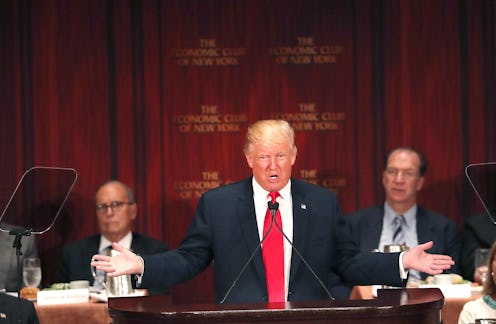News
Calm Down About Those Polls Already
I woke up this morning to a push notification from the New York Times on my phone. "Poll Shows Tight Race for Donald Trump and Hillary Clinton" was the headline, pointing to the Times' joint poll with CBS, showing Trump and Clinton tied among likely voters nationally at 44 percent in a two-way race, 42 percent when third party candidates Gary Johnson and Jill Stein were included. This is a big break from how the election looked just a few weeks ago — the same poll in early August gave Clinton a 5-point lead, and stupid pundits (like *cough* me) were touting the possibility of a Clinton landslide.
But now the headlines and the pundits have gone the other way. In the wake of a bad weekend for Clinton, new polls are coming out showing Trump gaining in key swing states. The narrative of the race has shifted from Clinton's dominance to Clinton being surprisingly weak against Trump.
The polls have certainly tightened. Trump has a better chance to win the presidency than he's had since the party conventions. He could definitely pull this off. But Clinton is still clearly far more likely to.
If you look at any of the major polling averages, you can see that Clinton is still coming out to about a two point lead when you take several national polls together. This is not so far from where the horse-race usually is. In the Huffington Post polling average (my personal favorite, since I'm a dork and get irrationally excited about chances to play with trend-line smoothing), her current lead is not far off from the usual difference, with some instances of her gaining and others of the polls tightening.
In Nate Silver's much-touted 538 forecast, Trump has made serious gains, which put him at...around a 35-40 percent chance to win, not far from the 34 percent chance when the forecast was launched in June at the beginning of the general election.
For all the ups-and-downs of the long presidential campaign, a look at history will show that elections and polling are actually...pretty stable. John Sides and Lynn Vavreck, a pair of political scientists who wrote about the 2012 election in their book The Gamble, pointed at that election to describe how for all the "game changers" that the media reports, presidential elections are less like a boxing match with knockout punches, than "a hard-fought tug-of-war — one in which the flag tied to the rope rarely moves very much."
The polls go up and down for many reasons — voters saying they're undecided when last week they were sure, changes in enthusiasm affect predictions of who will show up to vote, and bad news stories can discourage supporters of a candidate from talking to pollsters.
But the fundamental difference between two candidates usually gets baked in pretty solidly. The last time a candidate with Clinton's consistent lead this late lost was 1948. Of course, it's still possible for something big to change that makes Trump win. But it's important to understand the difference between headlines like "Trump Cuts Clinton Lead In Half" and saying Trump is going to win.
